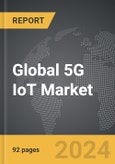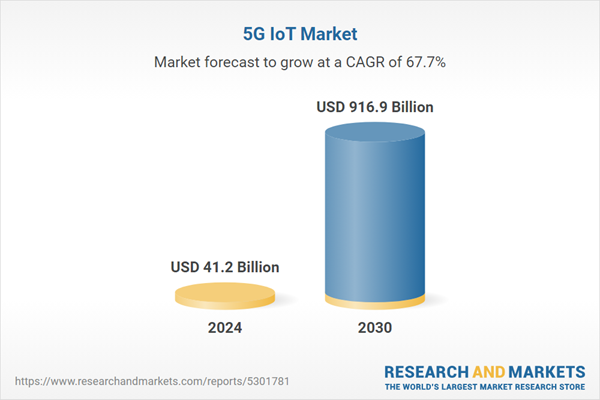The global market for 5G IoT was valued at US$41.2 Billion in 2024 and is projected to reach US$916.9 Billion by 2030, growing at a CAGR of 67.7% from 2024 to 2030. This comprehensive report provides an in-depth analysis of market trends, drivers, and forecasts, helping you make informed business decisions. The report includes the most recent global tariff developments and how they impact the 5G IoT market.
Segments: Radio Technology (5G NR Standalone Architecture, 5G NR Non-Standalone Architecture); Range (Short Range, Wide Range).
Geographic Regions/Countries: World; United States; Canada; Japan; China; Europe (France; Germany; Italy; United Kingdom; and Rest of Europe); Asia-Pacific; Rest of World.
The analysts continuously track trade developments worldwide, drawing insights from leading global economists and over 200 industry and policy institutions, including think tanks, trade organizations, and national economic advisory bodies. This intelligence is integrated into forecasting models to provide timely, data-driven analysis of emerging risks and opportunities.
Global 5G IoT Market - Key Trends and Drivers Summarized
How Is 5G IoT Shaping the Future of Connectivity?
The relationship between 5G and the Internet of Things (IoT) is foundational to the future of interconnected devices and systems, representing a major leap forward in global connectivity. At its core, 5G provides the speed, reliability, and low latency that are essential for IoT devices to function efficiently at scale. Unlike previous generations of wireless technology, 5G can handle a vastly larger number of devices, making it a perfect match for IoT, which is defined by networks of sensors, actuators, and smart devices exchanging data in real time. These IoT devices require seamless and instant communication, whether they are used in homes, factories, or cities, and 5G is designed to meet this need with its ultra-fast data transmission rates and ability to support massive machine-type communications (mMTC). The core infrastructure of 5G enables IoT applications to function reliably in high-density environments, such as smart cities or industrial settings, where hundreds of thousands of devices may be connected simultaneously. The synergy between 5G and IoT is thus essential for unlocking the potential of smart systems, autonomous technologies, and intelligent data analysis.How Is 5G IoT Transforming Key Sectors?
The transformative impact of 5G IoT is evident across multiple industries, driving innovation, efficiency, and new possibilities. In manufacturing, 5G IoT is leading to the development of highly automated factories that rely on interconnected devices and sensors to monitor and control production processes in real time. The ability to transmit large amounts of data quickly and reliably enables predictive maintenance, where machines can alert operators to potential breakdowns before they occur, significantly reducing downtime and maintenance costs. Healthcare is another sector experiencing profound changes due to 5G IoT, with applications like remote patient monitoring, wearable health devices, and even robotic surgery becoming increasingly feasible. With the low-latency capabilities of 5G, doctors can remotely monitor vital signs, diagnose illnesses, and even perform surgeries using robotic tools with precision, making healthcare more accessible and efficient. The transportation industry is also undergoing a revolution, as 5G IoT supports the development of connected and autonomous vehicles. These vehicles rely on real-time data from other cars, road sensors, and traffic systems to navigate safely and efficiently. Furthermore, smart city initiatives depend on 5G IoT to enable everything from intelligent traffic management systems to energy-efficient streetlights and smart waste management, leading to more sustainable urban environments.What Challenges Does 5G IoT Face in Reaching Its Full Potential?
Despite its transformative potential, the deployment of 5G IoT faces several significant challenges that could slow its widespread adoption. One of the primary obstacles is the need for substantial infrastructure investment, as 5G networks require dense deployments of small cells and fiber-optic connections to support the high speeds and low latency that IoT applications demand. This infrastructure is particularly necessary in urban areas, where the density of devices and sensors will be highest, but it also presents logistical and regulatory challenges, such as securing permits and coordinating with local authorities. Another challenge lies in ensuring the security and privacy of IoT devices connected to 5G networks. The sheer number of devices connected in a 5G IoT ecosystem creates an expansive attack surface, making it difficult to secure every entry point. Cybersecurity is therefore a critical concern, as vulnerabilities in IoT devices can be exploited to disrupt entire networks or steal sensitive data. Additionally, the standardization of IoT protocols across different industries and regions remains a complex issue. While 5G provides the backbone for IoT connectivity, ensuring that devices from different manufacturers and industries can communicate with each other seamlessly is a hurdle that still needs to be addressed. Lastly, there is the issue of power consumption, as many IoT devices are battery-powered and need to operate for long periods without maintenance. While 5G is designed to be energy-efficient, ensuring that IoT devices can last for years without needing battery replacements or recharging will be crucial for their widespread use in remote or hard-to-reach locations.What Factors Are Driving the Growth of the 5G IoT Market?
The growth in the 5G IoT market is driven by several factors, rooted in technological advancements and evolving consumer and industrial needs. One of the most significant drivers is the increasing demand for real-time data processing and connectivity across a wide range of devices and applications. As industries and consumers adopt more IoT devices, the need for a robust network that can handle large volumes of data transmission has become critical. 5G’s ability to support ultra-reliable, low-latency communication (URLLC) is a key enabler for this growth, especially in industries like autonomous driving, where real-time decision-making is essential. Another driver is the rapid rise of smart city initiatives, where governments and urban planners are turning to IoT and 5G to solve complex urban challenges, from traffic congestion to energy management. These smart cities rely heavily on interconnected sensors, cameras, and control systems that need a reliable network like 5G to function optimally. In the industrial sector, the push for automation and digitalization is also a major growth driver for 5G IoT, as industries increasingly turn to smart devices and automated systems to improve productivity, reduce costs, and enhance safety. Additionally, consumer behavior is evolving, with a growing demand for connected homes, smart appliances, and wearable technology, all of which require the fast, seamless connectivity that 5G provides. Lastly, the development of private 5G networks tailored for specific enterprise needs, such as in mining, agriculture, or logistics, is creating new opportunities for 5G IoT growth. These private networks offer dedicated, secure connectivity, allowing businesses to leverage IoT technologies in mission-critical applications without the risk of network congestion or interference. Combined with favorable government policies and investments in 5G infrastructure, these factors are ensuring that the 5G IoT market will experience significant expansion in the coming years.Report Scope
The report analyzes the 5G IoT market, presented in terms of units. The analysis covers the key segments and geographic regions outlined below.Segments: Radio Technology (5G NR Standalone Architecture, 5G NR Non-Standalone Architecture); Range (Short Range, Wide Range).
Geographic Regions/Countries: World; United States; Canada; Japan; China; Europe (France; Germany; Italy; United Kingdom; and Rest of Europe); Asia-Pacific; Rest of World.
Key Insights:
- Market Growth: Understand the significant growth trajectory of the 5G NR Standalone Architecture segment, which is expected to reach US$681.6 Billion by 2030 with a CAGR of a 69.2%. The 5G NR Non-Standalone Architecture segment is also set to grow at 63.9% CAGR over the analysis period.
- Regional Analysis: Gain insights into the U.S. market, valued at $13.4 Billion in 2024, and China, forecasted to grow at an impressive 62.8% CAGR to reach $114.0 Billion by 2030. Discover growth trends in other key regions, including Japan, Canada, Germany, and the Asia-Pacific.
Why You Should Buy This Report:
- Detailed Market Analysis: Access a thorough analysis of the Global 5G IoT Market, covering all major geographic regions and market segments.
- Competitive Insights: Get an overview of the competitive landscape, including the market presence of major players across different geographies.
- Future Trends and Drivers: Understand the key trends and drivers shaping the future of the Global 5G IoT Market.
- Actionable Insights: Benefit from actionable insights that can help you identify new revenue opportunities and make strategic business decisions.
Key Questions Answered:
- How is the Global 5G IoT Market expected to evolve by 2030?
- What are the main drivers and restraints affecting the market?
- Which market segments will grow the most over the forecast period?
- How will market shares for different regions and segments change by 2030?
- Who are the leading players in the market, and what are their prospects?
Report Features:
- Comprehensive Market Data: Independent analysis of annual sales and market forecasts in US$ Million from 2024 to 2030.
- In-Depth Regional Analysis: Detailed insights into key markets, including the U.S., China, Japan, Canada, Europe, Asia-Pacific, Latin America, Middle East, and Africa.
- Company Profiles: Coverage of players such as AT&T, Bell Canada, BT Group, Ericsson, Etisalat and more.
- Complimentary Updates: Receive free report updates for one year to keep you informed of the latest market developments.
Some of the 36 companies featured in this 5G IoT market report include:
- AT&T
- Bell Canada
- BT Group
- Ericsson
- Etisalat
- Huawei
- Nokia
- Rogers
- Singtel
- Sprint
- Telefónica
- Telstra
- Telus
- Verizon
- Vodafone
Tariff Impact Analysis: Key Insights for 2025
Global tariff negotiations across 180+ countries are reshaping supply chains, costs, and competitiveness. This report reflects the latest developments as of April 2025 and incorporates forward-looking insights into the market outlook.The analysts continuously track trade developments worldwide, drawing insights from leading global economists and over 200 industry and policy institutions, including think tanks, trade organizations, and national economic advisory bodies. This intelligence is integrated into forecasting models to provide timely, data-driven analysis of emerging risks and opportunities.
What’s Included in This Edition:
- Tariff-adjusted market forecasts by region and segment
- Analysis of cost and supply chain implications by sourcing and trade exposure
- Strategic insights into geographic shifts
Buyers receive a free July 2025 update with:
- Finalized tariff impacts and new trade agreement effects
- Updated projections reflecting global sourcing and cost shifts
- Expanded country-specific coverage across the industry
Table of Contents
I. METHODOLOGYII. EXECUTIVE SUMMARY2. FOCUS ON SELECT PLAYERSIII. MARKET ANALYSISIV. COMPETITION
1. MARKET OVERVIEW
3. MARKET TRENDS & DRIVERS
4. GLOBAL MARKET PERSPECTIVE
UNITED STATES
CANADA
JAPAN
CHINA
EUROPE
FRANCE
GERMANY
ITALY
UNITED KINGDOM
REST OF EUROPE
ASIA-PACIFIC
REST OF WORLD
Companies Mentioned (Partial List)
A selection of companies mentioned in this report includes, but is not limited to:
- AT&T
- Bell Canada
- BT Group
- Ericsson
- Etisalat
- Huawei
- Nokia
- Rogers
- Singtel
- Sprint
- Telefónica
- Telstra
- Telus
- Verizon
- Vodafone
Table Information
| Report Attribute | Details |
|---|---|
| No. of Pages | 92 |
| Published | April 2025 |
| Forecast Period | 2024 - 2030 |
| Estimated Market Value ( USD | $ 41.2 Billion |
| Forecasted Market Value ( USD | $ 916.9 Billion |
| Compound Annual Growth Rate | 67.7% |
| Regions Covered | Global |









